From portioning to selecting the best meats, this step-by-step guide will teach you everything you need to know to make the ultimate charcuterie board!
Cured meats, creamy cheeses, buttery crackers and an assortment of bite-sized treats all arranged neatly on a platter — a good charcuterie board is the star of any gathering.
More than just an appetizer, the best charcuterie boards serve as an ice breaker and inspire conversation. People gravitate towards the board, chatting and grazing on the variety of small snacks. And the bite-sized portions often encourage people to try something new like a funky cheese or unique jam — it’s a whole experience!
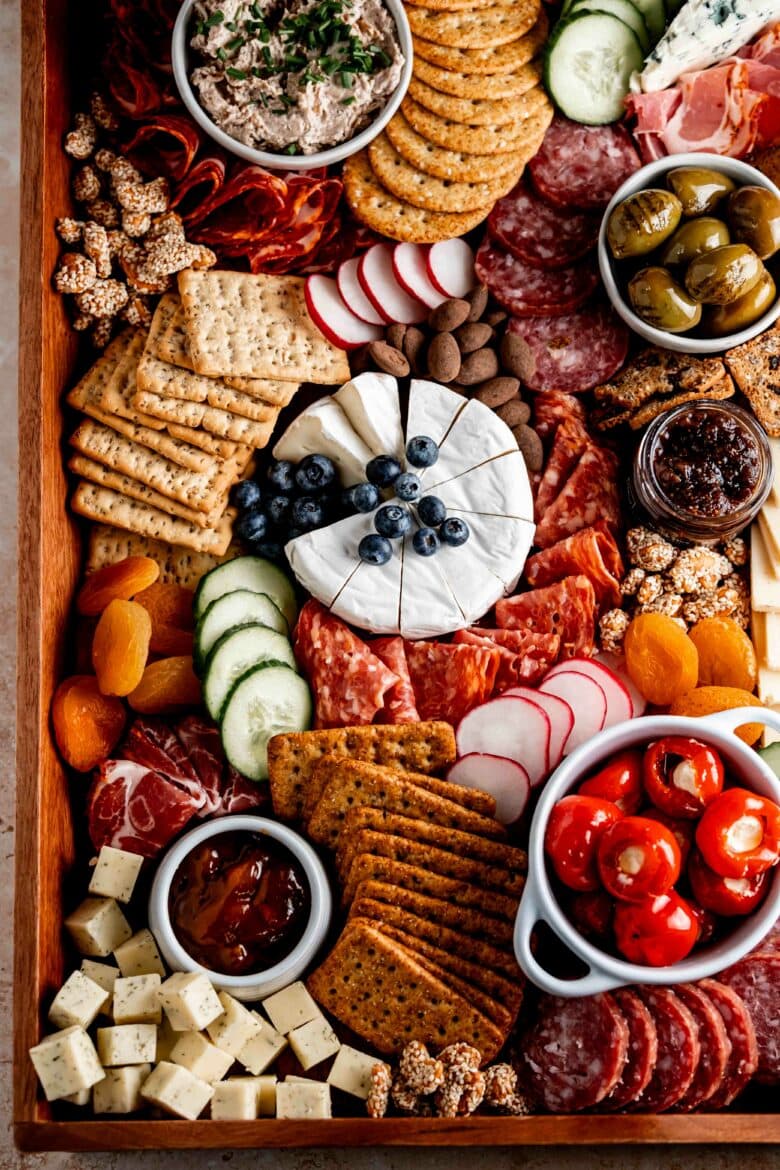
How to build an epic charcuterie board
This guide to making a charcuterie board will take the guesswork out of putting together the best meat and cheese platter so you can whip up your masterpiece in under half an hour!
Charcuterie boards and tools
Okay, let’s back up for one minute. First we need to choose the actual board. This can be almost any material: wood, marble, granite or even metal. While I tend to place the ingredients directly on the surface, you can always layer the board with parchment paper if you’d like!
In addition to the actual board, here are some other utensils and items you might want to round up:
- Small bowls or ramekins for containing dips, jams or pickled ingredients
- Cheese knives, small spoons and honey dippers for slicing, spreading, and drizzling
- Toothpicks and tongs to easily pick up small items
- Small serving plates and napkins for guests to take snacks away from the board
Meats
The term charcuterie traditionally refers to a selection of cured or processed meats, so you technically can’t have a charcuterie board without the meat!
Aim for a diverse selection of meats on your charcuterie board. Include a mix of cured, uncured and smoked meats, as well as pâtés or terrines.
My charcuterie boards tend to include various types of salami (from the Italian word salume), such as genoa, sopressata and pepperoni. I also like to add other cured and uncured meats, such as prosciutto, bresaola and coppa.
And if you want to get really fancy, check our our guide to making salami roses!
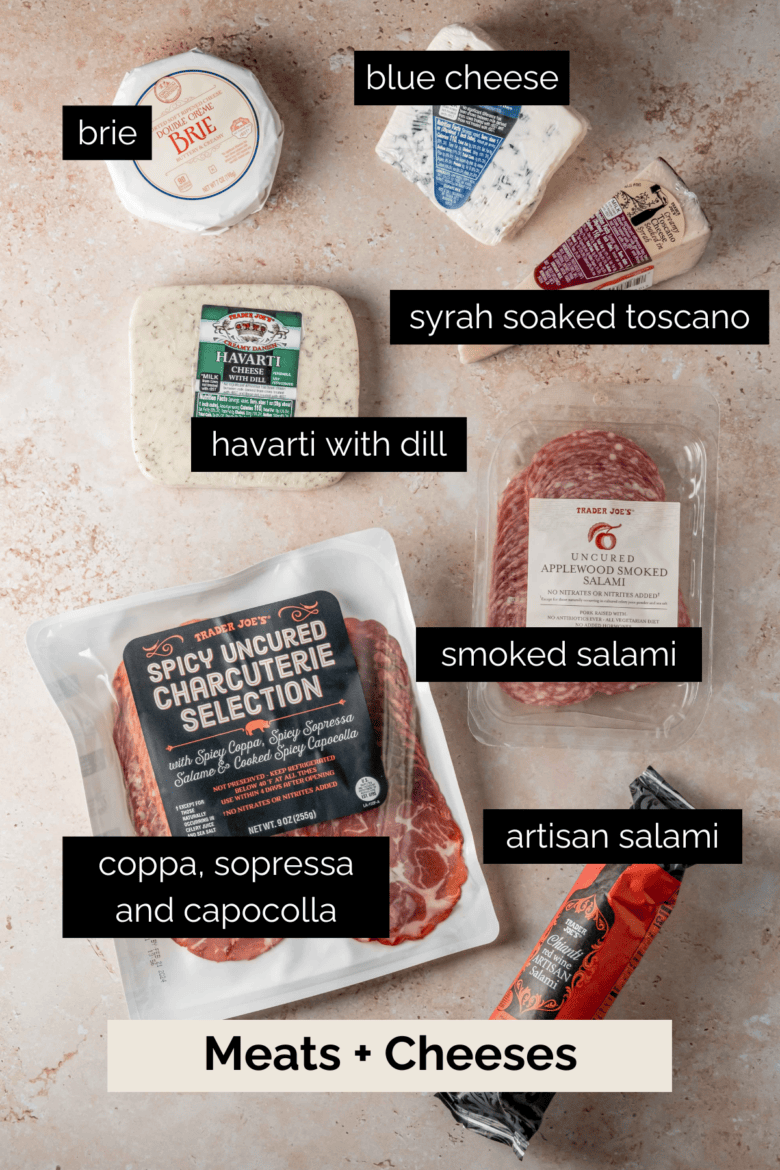
Cheeses
The amount of cheese you choose for your charcuterie board will depend on your number of guests. But even for small gatherings I recommend choosing at least one cheese from each of these categories:
- Hard and semi-hard cheese: This category of cheese includes gouda, cheddar, asiago, havarti and many more. I prefer to cut these cheeses into cubes or slices.
- Soft cheese: I almost always opt for a wheel of soft-ripened cheese, such as brie or camembert. I recommend cutting the cheese into wedges to make it easier for guests to grab.
- Blue cheese or goat cheese: This cheese I tend to leave in wedge or log form, as it’s soft enough for guests to easily cut with a cheese knife.
- Wildcard (optional): If I have more than six guests, I also opt for a wildcard cheese. This is generally something fun and adventurous, such as a ghost pepper cheddar or cranberry gouda.
Check out this cheese pairings guide for ideas on how to pair your favorite cheeses with fruit and spirits!
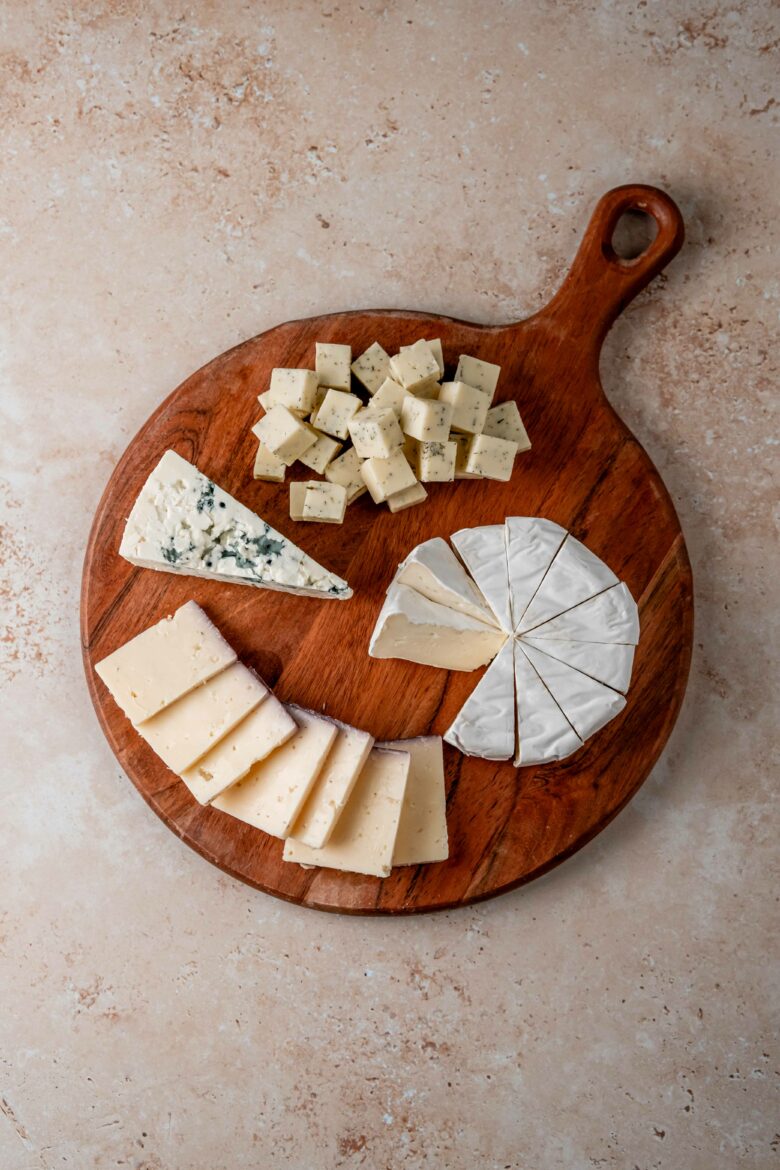
Bread and crackers
When choosing the bread and crackers for your charcuterie board, you can choose an assortment pack of crackers or curate your own selection by choosing 3-4 different types. Here are some of our favorite options:
- Baguette slices
- Buttery crackers
- Multigrain crackers
- Pita chips
- Water crackers
- Grissini (crispy Italian breadsticks)
For the bread and crackers, don’t get too crazy with flavor. These are the blank canvases to showcase your meats and cheeses.
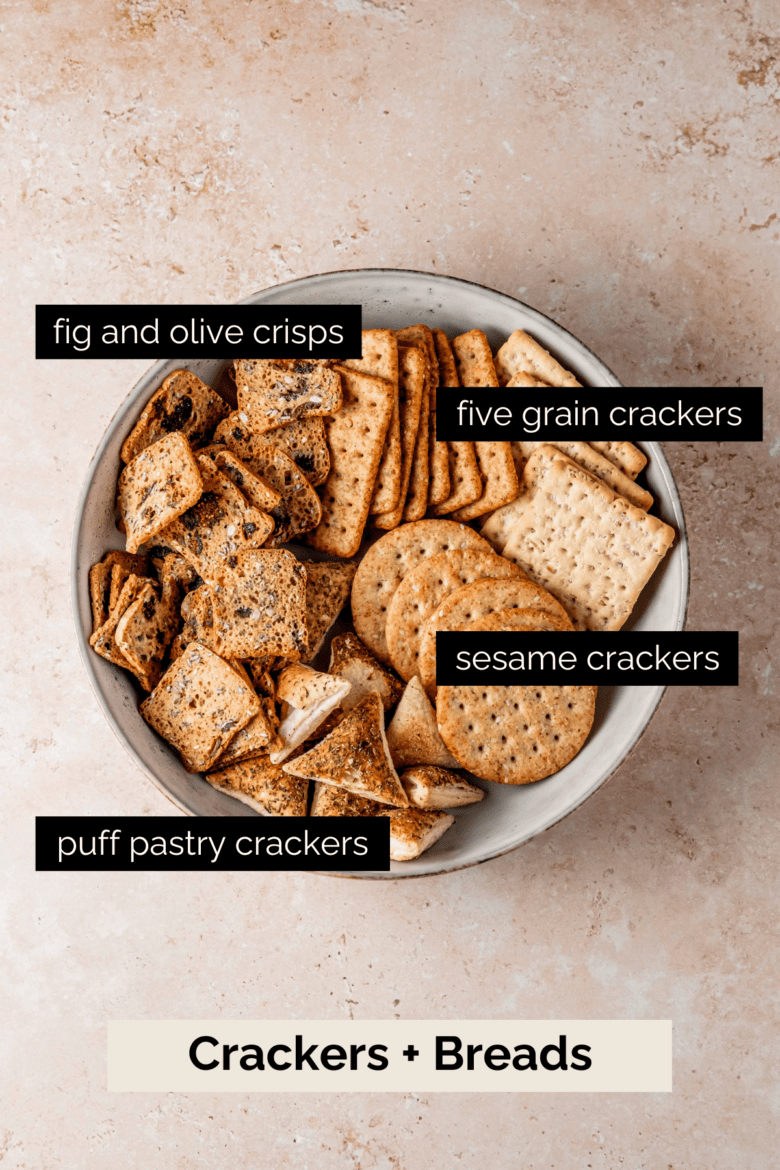
Fruits and vegetables
For the fruits on the charcuterie board, I generally choose at least one dried fruit and one fresh fruit. When selecting your fruits, here are a few things to consider:
- Try to pick one sweet fruit (such as dried apricots, dried figs or grapes) and one tart fruit (such as blueberries, kiwi or pomegranate).
- Choose in-season fruits for the freshest and most flavorful options.
- If using fruits prone to browning, such as apple slices, cut and place them on your board right before serving.
And here are a few recommendations for choosing your vegetables:
- Pick vegetables that pair well with the dips or spreads you choose, such as carrots, cucumbers and celery.
- Don’t forget about color! Veggies are a great way to turn a beige board into a colorful masterpiece. Bell peppers and radishes are some of my favorite options for more color.
- Cut the vegetables into bite-sized pieces, such as slices or sticks.
Expert Tip: When choosing ingredients, think about contrast. You want a variety of textures, flavors and colors!
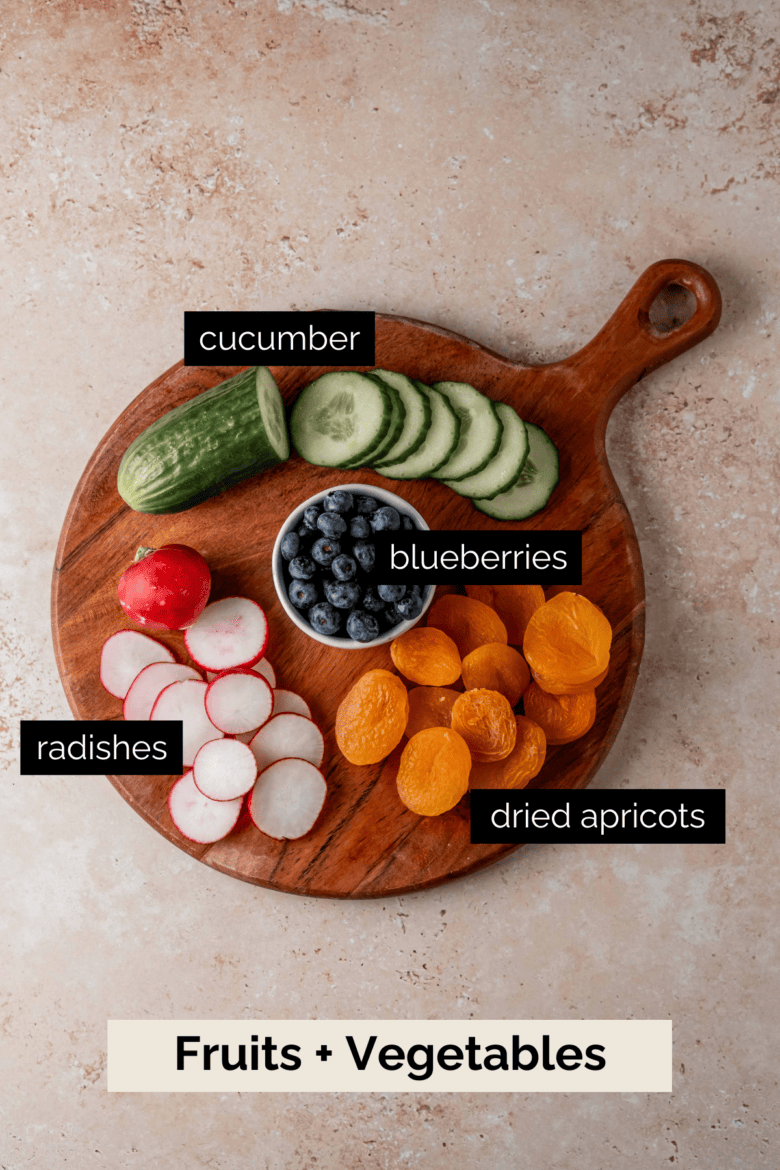
Condiments, dips and spreads
When it comes to dips and spreads, the options are endless! I recommend picking at least one from each of these categories:
- Savory: Hummus, spinach dip, tzatziki and white bean dip are always popular options. For this specific charcuterie board, I made caramelized onion yogurt dip.
- Sweet: Fig jam, raspberry preserves and honey are my go-to options in this category.
- Tangy: Dijon mustard, olive tapenade and mango chutney all make for excellent additions.
Accents
The accents are the last element of your charcuterie board. They’re the little accompaniments or tiny treats that add a pop of acidity or sweetness to the spread. I recommend choosing two sweet accents and two tangy accents.
For the sweet accents, I almost always opt for one candied nut and one chocolate accent. Chocolate accents can include truffles, candies and chocolate covered nuts, pretzels or fruit.
As for the tangy accents, I like to choose one pickled item and one marinated item. Pickled items can include cornichons, pickled peppers and even pickled onions or garlic. Marinated items include things like olives, artichoke hearts and mushrooms.
Expert tip: Place pickled and marinated items in small bowls to keep any excess liquid from seeping into the surrounding ingredients.
Garnishes (optional)
I didn’t use any additional garnishes on this charcuterie board. But if I feel like my board needs a pop of color or just a little something extra, I’ll often add one or two of the following:
- Fresh herbs
- Edible flowers
- Microgreens
- Honeycomb
- Candied fruit peel (this could also be a sweet accent)
- Chocolate shavings
- Pomegranate arils
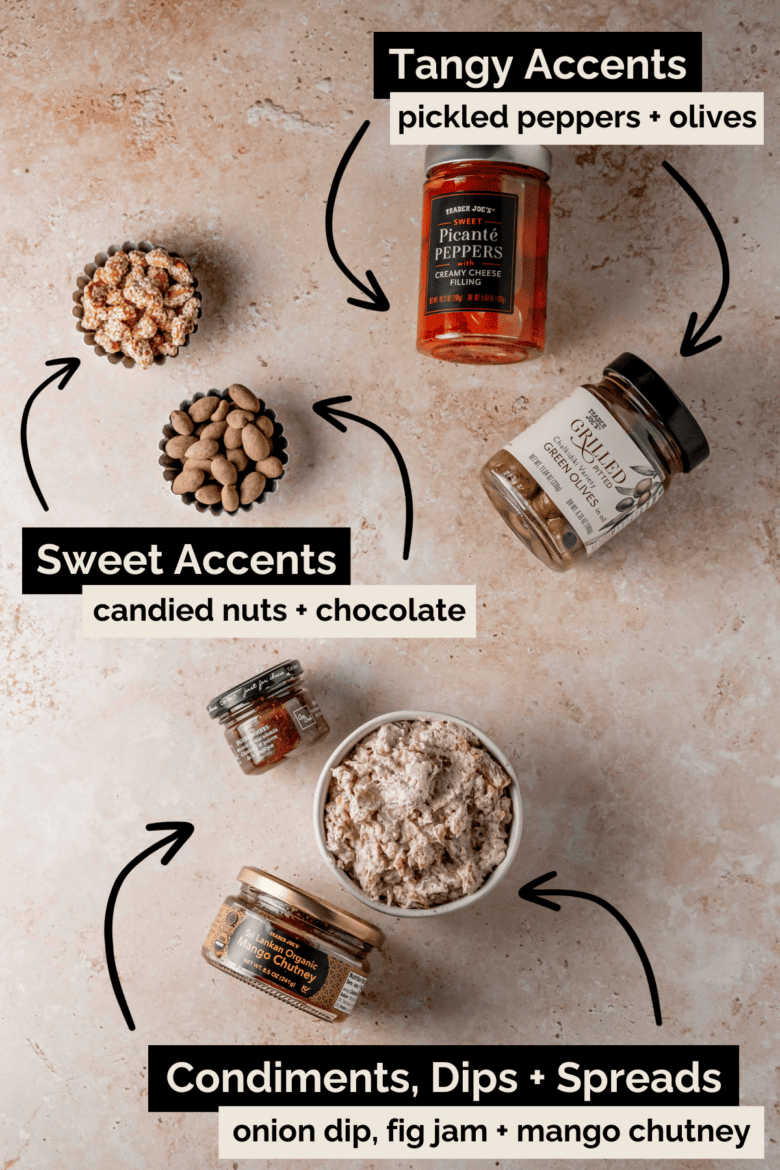
Charcuterie portioning
This handy table will show you how much food to plan per person for your charcuterie board. Keep in mind that these are approximate amounts, as ingredients come in varying sizes. And trust your judgment, as you know your guests better than anyone!
| Ingredient | Appetizer | Main |
|---|---|---|
| Meats | 1.5-2 ounces (43-57 grams) per person | 3-4 ounces (85-113 grams) per person |
| Cheese | 1.5-2 ounces (43-57 grams) per person | 3-4 ounces (85-113 grams) per person |
| Bread and crackers | 5-6 pieces per person | 8-10 pieces per person |
| Fresh vegetables | 3 bite-sized pieces per person | 6 bite-sized pieces per person |
| Fruit (fresh and dried) | 3 bite-sized pieces per person | 6 bite-sized pieces per person |
| Condiments, dips and spreads | 1-2 tablespoons per person | 3-4 tablespoons per person |
| Sweet accents | 2 bites per person | 3 bites per person |
| Tangy accents | 2 bites per person | 3 bites per person |
Arranging and styling your board
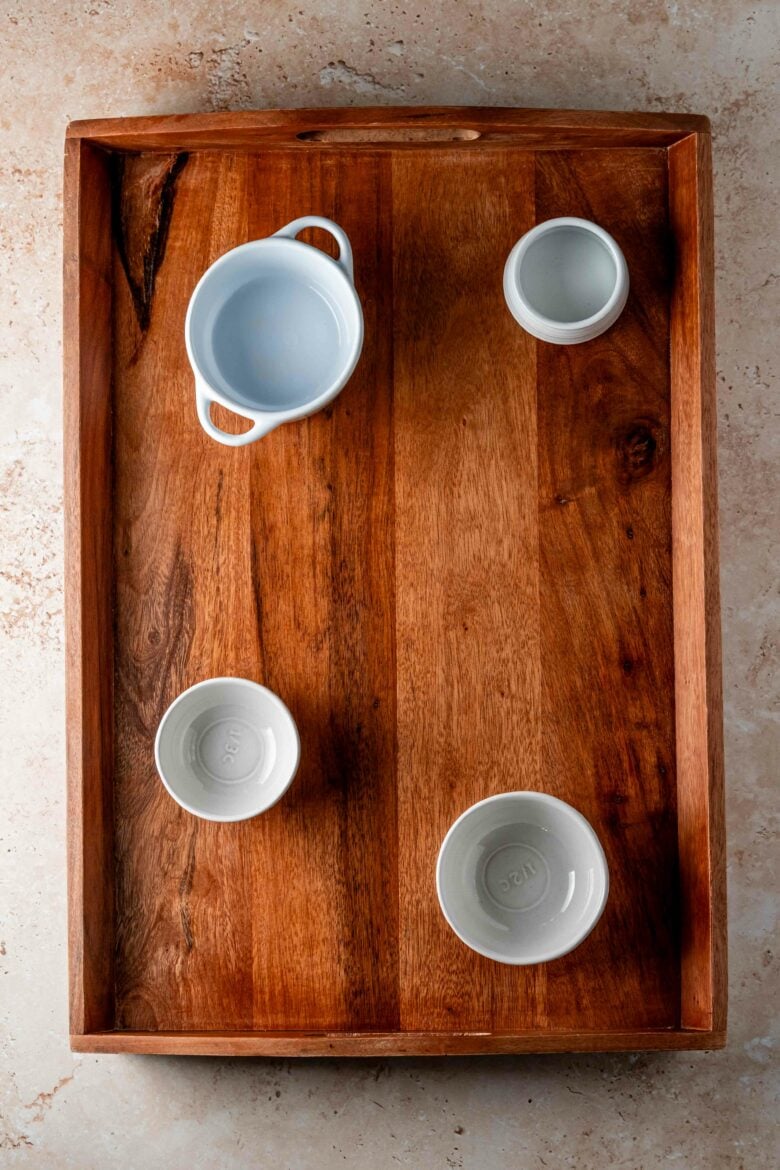
Step 1: Choose your board, ramekins and dishes. You’ll need small dishes to hold condiments, dips and pickled or marinated ingredients. Strategically position these elements across the charcuterie board evenly for a visually balanced composition. These bigger elements, along with the larger cuts of cheese, serve as visual anchors.
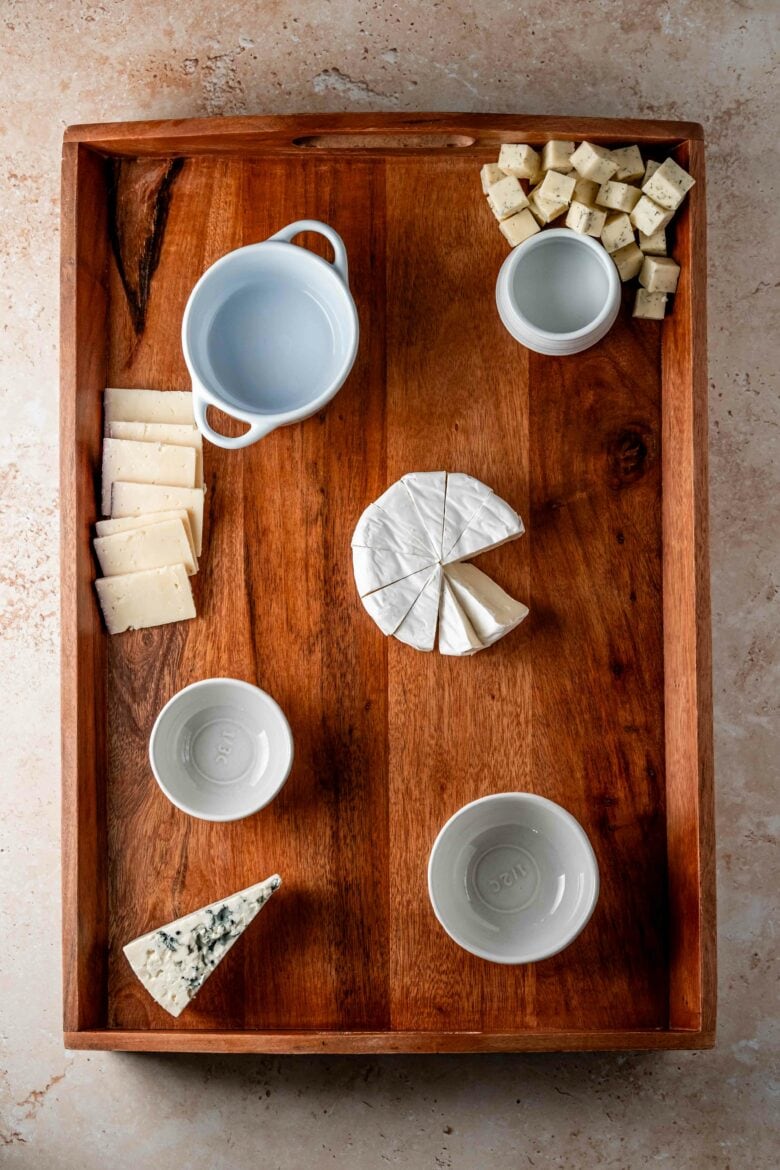
Step 2: Cut and position the cheese on the board. Cut the cheese into a variety of shapes (wedges, slices, cubes, etc.). Position the cheeses evenly across the board.
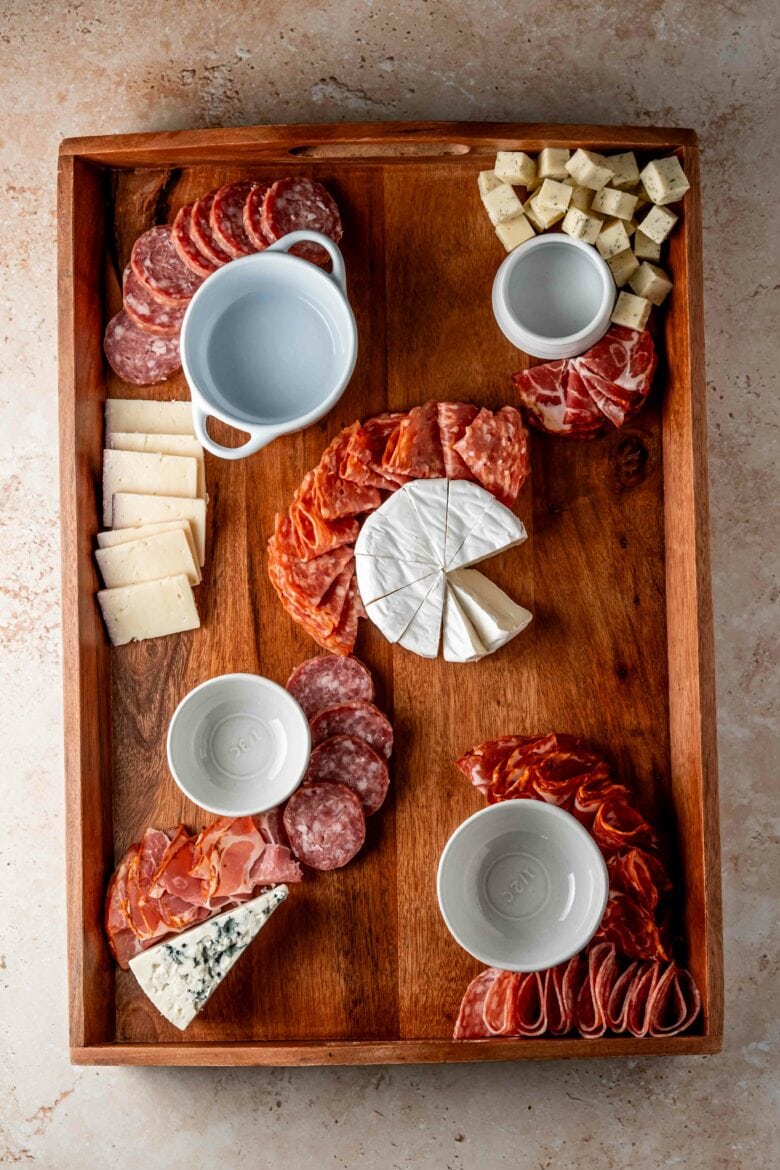
Step 3: Arrange the meats around the cheese and dishes. Cut any whole salami into rounds. Thinly sliced meats can be folded in half once or twice, making it easier for guests to pick up.
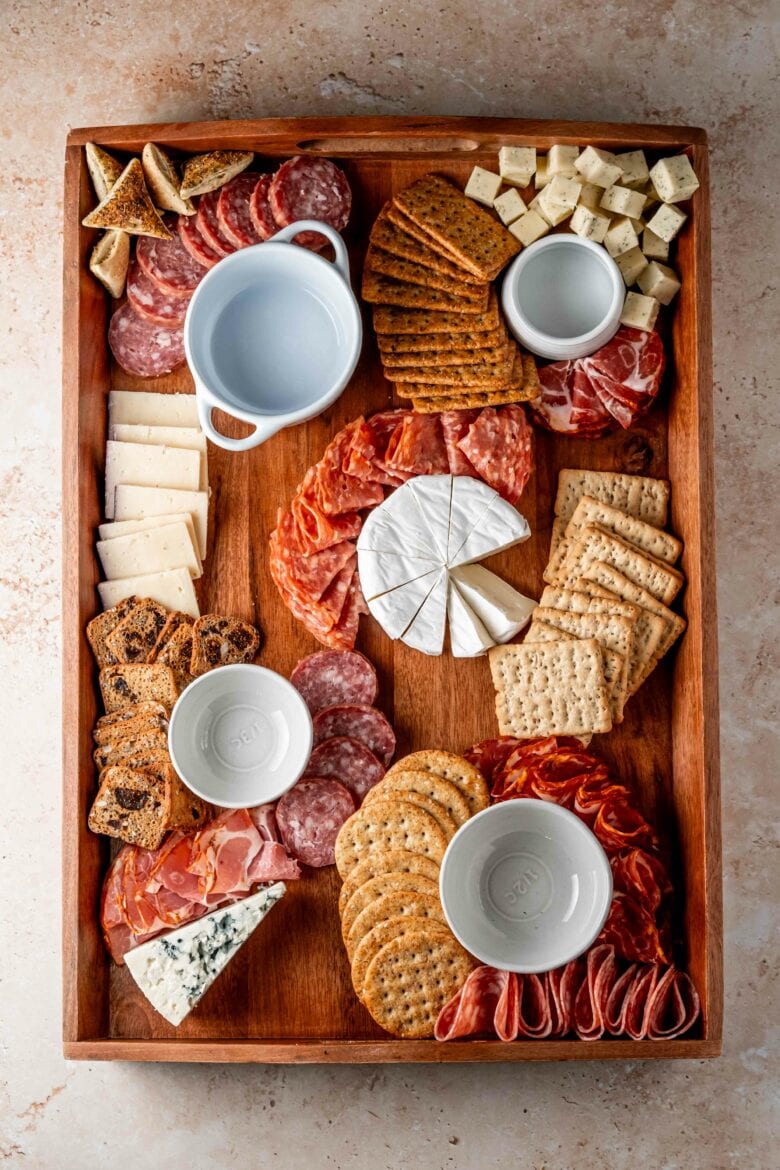
Step 4: Place the crackers and breads on the board. Make sure to leave space for the vegetables, fruits and accents. If you have too many crackers, you can place any extras on a serving platter on the side.
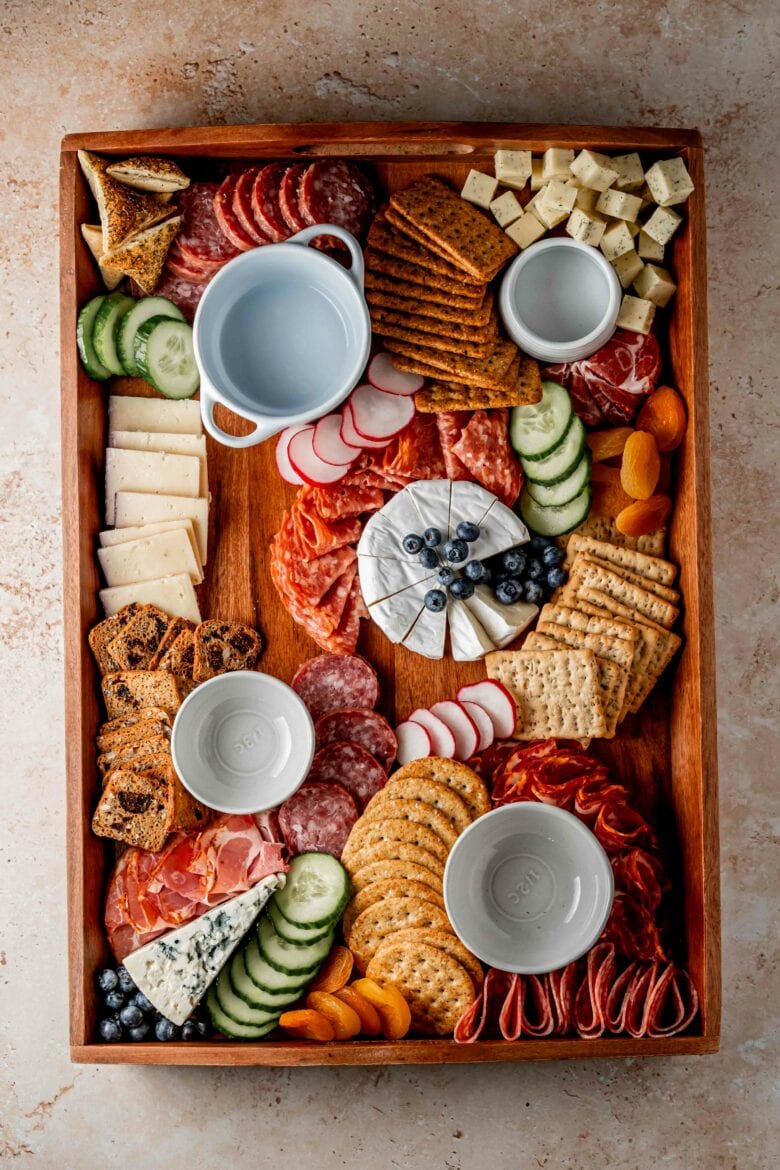
Step 5: Cut the fruits and vegetables into bite-sized pieces and place on the board. Pay attention to color and position the fruits and vegetables so pops of color appear throughout the board.
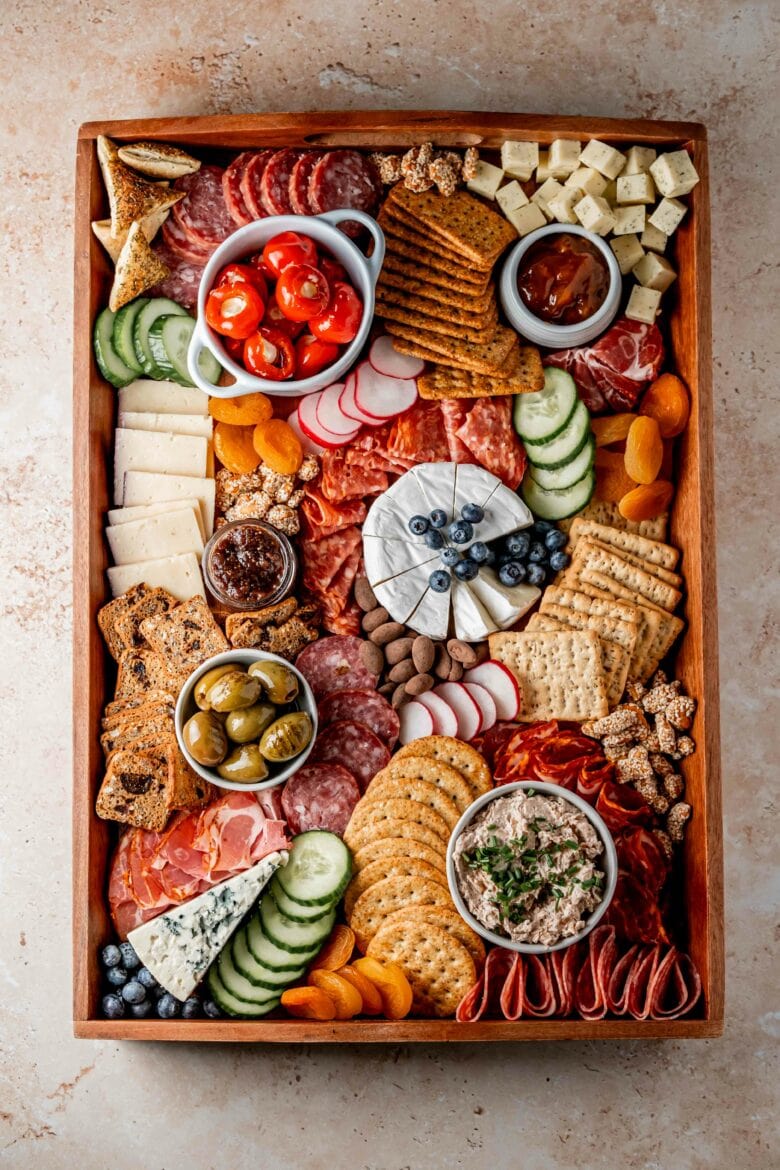
Step 6: Fill in any gaps with the sweet and tangy accents. Add the dips and condiments to the small bowls. Place the ingredients that complement each other together. For example, you might place sweet accents near the brie.
Make ahead and storage
You can prepare your charcuterie board a day in advance for stress-free entertaining. After arranging the meats and cheeses, cover the entire board with plastic wrap to keep everything fresh.
For the ultimate crunch factor, hold off on adding nuts, crackers, or any other crispy elements until just before serving. This ensures they maintain their texture without getting soggy.
Transporting your charcuterie board? Safeguard the filled serving bowls by wrapping each one individually with plastic wrap. To keep the entire masterpiece secure, lay out a sheet of foil and carefully wrap it around the board.
Expert tips and tricks
- Avoid adding too many ingredients when assembling your charcuterie board to prevent overwhelming guests and making it challenging to find specific items. Choose 2-3 centerpieces to maintain an inviting and visually balanced presentation.
- Keep your charcuterie board fresh by replenishing halfway through the gathering. Have crackers and accents nearby for quick and seamless refills.
- Allow the board to sit at room temperature for about 30 minutes before serving. This brings the cheese and meats to an ideal temperature for the best flavor and texture.
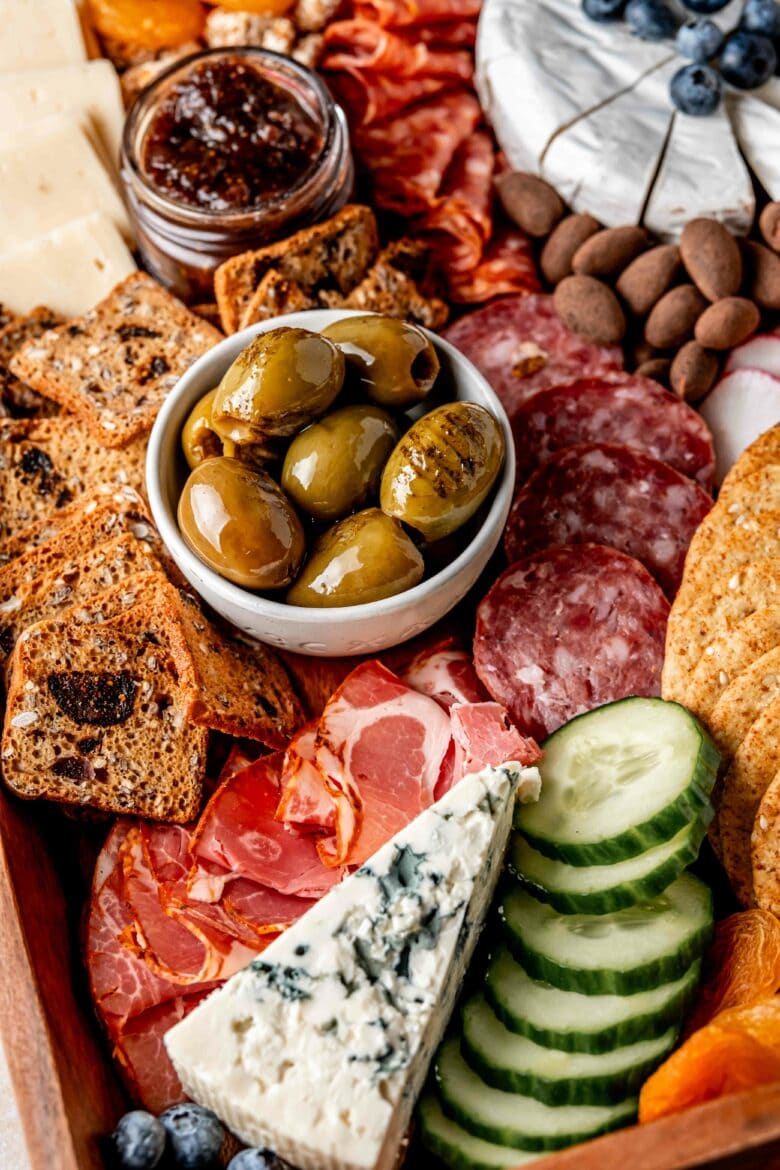
FAQs
The word charcuterie (pronounced shahr-koo-tuh-ree) is a French term that refers to the process of preparing meat products, primarily from pork. However, today when someone refers to charcuterie, they’re typically referring to a meat and cheese platter that includes meats, a variety of cheeses and other accompaniments, such as nuts, condiments, fruits and veggies!
Charcuterie boards are extremely customizable, but you’ll generally find cured meats, cheeses, crackers, vegetables, fruits, condiments and other small accompaniments, such as nuts and olives.
The 3333 rule is a simplified rule for charcuterie boards that suggests using 3 meats, 3 cheeses, 3 starches (breads and crackers) and 3 accompaniments. We find that the best boards have a bit more variety, but this rule still serves as an excellent foundation and starting point!
My top two tips for making your charcuterie board more affordable are:
1. Raid your pantry! You probably already have mustards, jams, nuts or dried fruits perfect for the occasion!
2. Costco and ALDI are your best bet for meats, cheeses and crackers on a budget. The salami variety packs are generally a pretty good deal!
I used a 12×24 inch (30×60 cm) serving tray for the 10-person charcuterie board pictured in this post. It was just a bit too small, so I served additional crackers on the side and refilled the vegetables, fruits and accents as needed.
Where to shop
You can find items for your charcuterie board from any of your favorite stores. I love Costco for their salami variety packs. And Trader Joe’s and ALDI are my go-tos for cheese, crackers, jams and accents! Trader Joe’s is also so much fun for seasonal products like pumpkin-flavored accents or jingle jangle (chocolate-covered pretzels and popcorn).
I’m also a fan of having one or two homemade dips on the board. This Walnut and Caramelized Onion Yogurt Dip is great with crackers and veggies. Or if you’d like to add a warm element to the board, my favorites are Baked Brie with Jam and Baked Goat Cheese Dip.
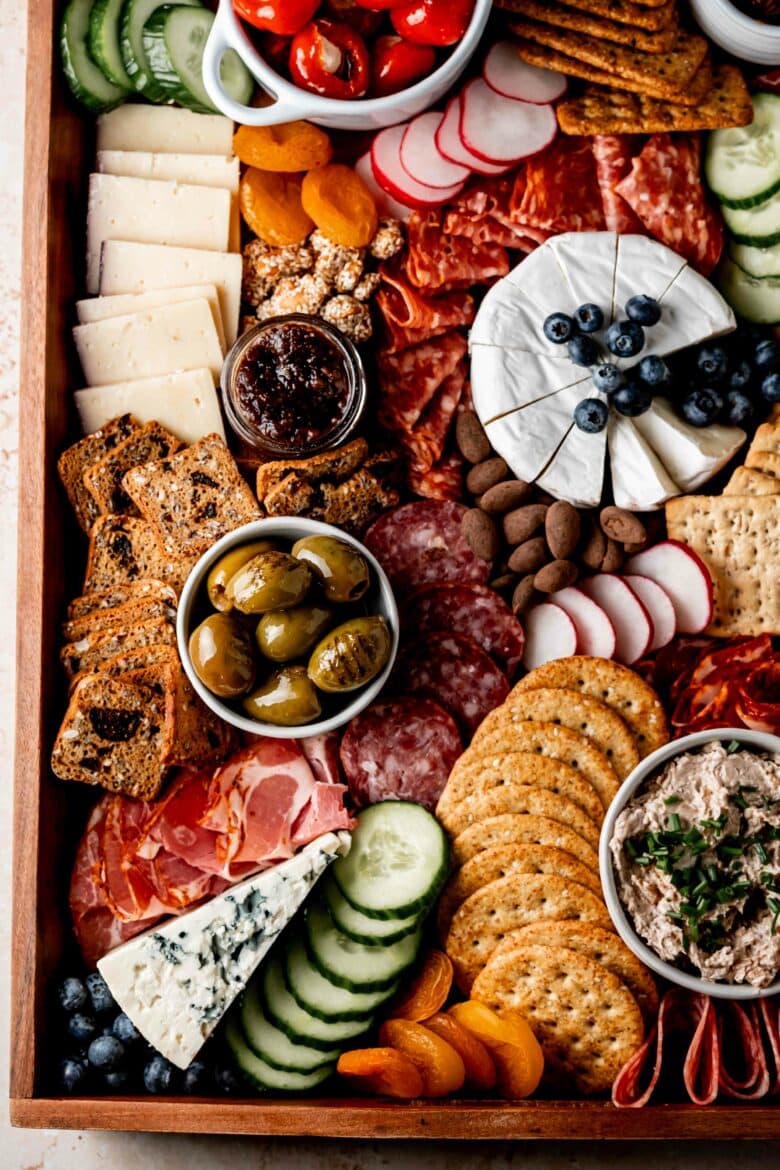
Charcuterie board inspiration
Charcuterie boards are the perfect way to get creative. You can build a board or snack platter around a season, holiday or really anything! I absolutely love a good theme and here are some of my favorite ideas:
- Valentine’s Board: Chocolate, strawberries and heart-shaped cookies — this board should go heavy on the sweets!
- Spring Crudité Platter: Serve a medley of fresh and vibrant vegetables alongside several complementary dips.
- Oktoberfest Platter: Featuring soft pretzels and a selection of mustards!
- Thanksgiving Grazing Board: Is the turkey ready yet? Who cares! You’re snacking on a meat and cheese platter complete with cranberry chutney and fried sage leaves!
- New Year’s Eve Board: This one’s all about decadence. Think prosecco-soaked berries, fancy canapes and indulgent chocolate truffles.
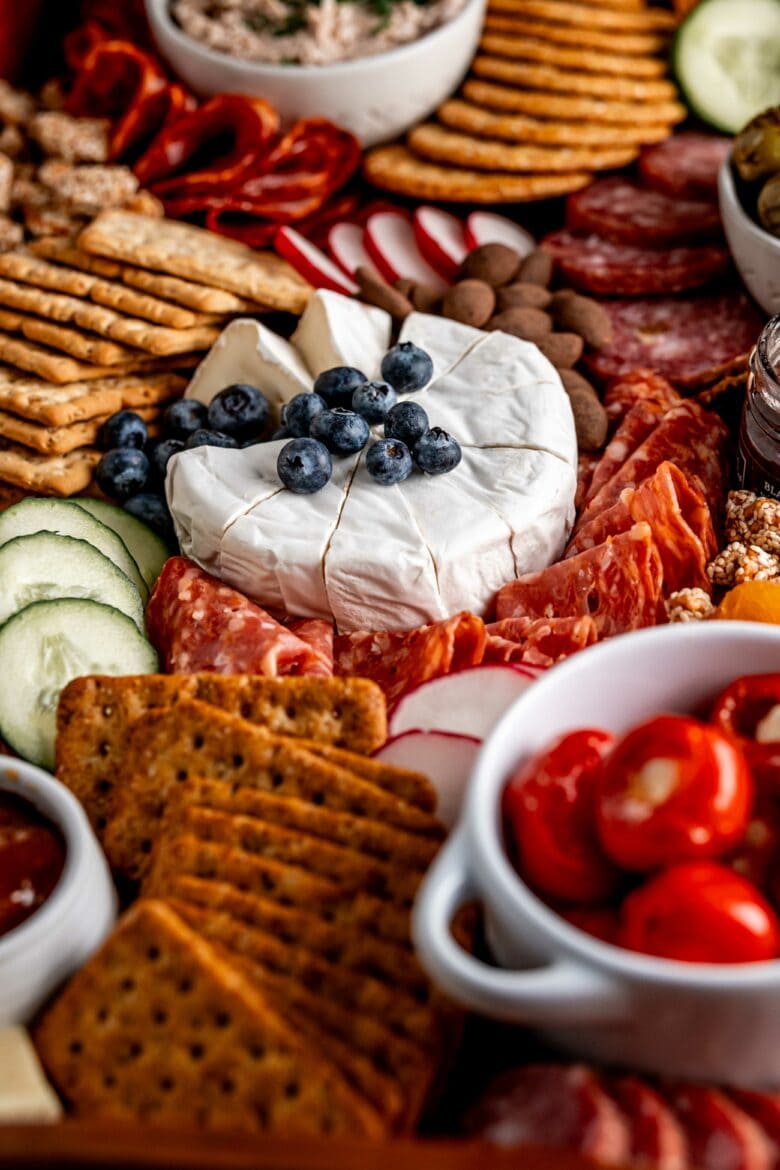
For more themed boards and platters, make sure to check out these ideas:
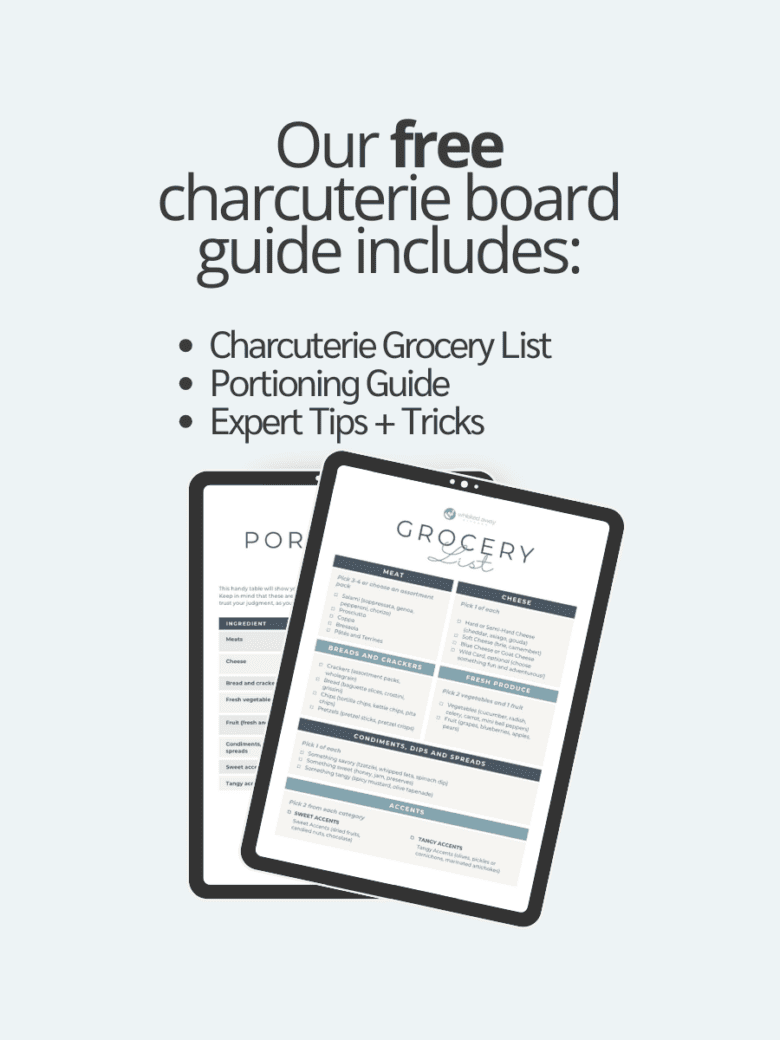
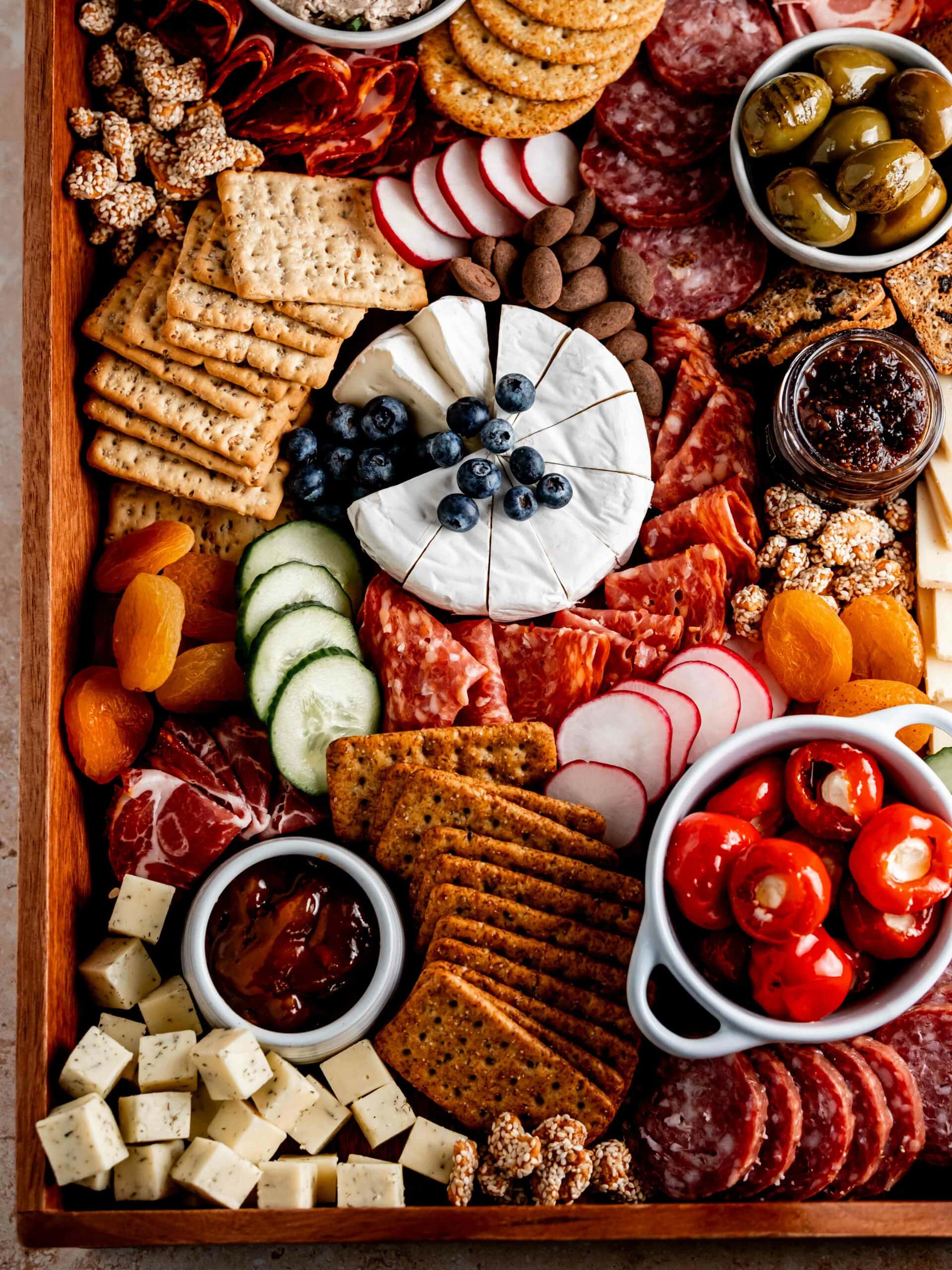
Charcuterie Board Recipe
- Total Time: 20 minutes
- Yield: 10
- Prep Time: 20 minutes
- Category: Appetizer
- Method: No Cooking
- Cuisine: French
Ingredients
Meat
- 16 ounces (450 grams) cured and processed meats (choose at least 3 varieties: salami, soppressata, prosciutto, chorizo, etc.)
Cheese
- 4 ounces (115 grams) hard cheese or semi-hard cheese (gouda, cheddar, havarti, gruyere, etc.)
- 4 ounces (115 grams) soft cheese (brie, camembert, etc.)
- 4 ounces (115 grams) blue cheese or goat cheese
- 4 ounces (115 grams) wildcard cheese (choose something adventurous, such as a spicy cheese or fruit-infused cheese!)
Bread and Crackers
- 3 types of crackers or bread (crackers, baguette slices, pita chips, etc.)
Fruits and Vegetables
- 2 types of fresh vegetables (cucumbers, radishes, carrots, celery, etc.)
- 1 type of fresh fruit (blueberries, grapes, apples, raspberries, strawberries, etc.)
- 1 type of dried fruit (apricots, dates, figs, cranberries, etc.)
Condiments, Dips and Spreads
- ½ cup (about 120 grams) savory dip or spread (onion dip, tzatziki, spinach dip, etc.)
- ¼ – ½ cup (about 60–120 grams) sweet condiment or dip (honey, jam, etc.)
- ¼ – ½ cup (about 60–120 grams) tangy condiment (mustard, olive tapenade, chutney, etc.)
Accents
- ½ cup (generous handful) nuts (candied nuts, roasted nuts, spiced nuts or plain nuts)
- ½ cup (generous handful) small chocolates (chocolate covered nuts, truffles, etc.)
- ½ cup (generous handful) pickled item (cornichons, pickled peppers, etc.)
- ½ cup (generous handful) marinated item (olives, marinated artichoke hearts, etc.)
Instructions
- Start with the small dishes. Evenly space out any dishes or ramekins that you’ll be using for condiments, dips or accents on your board.
- Add the cheese. Cut the cheese into a variety of shapes (wedges, cubes, slices, etc.) and evenly space out on the board.
- Fold and add the cured meats.* Arrange the meats around the cheeses.
- Add the bread and crackers. If you don’t have much space left, consider serving additional crackers on a separate platter.
- Arrange the fruits and vegetables. Cut the vegetables and fruits into bite-sized pieces. Place them on the board, making sure to pay attention to color for a well-balanced and visually appealing board.
- Fill in any gaps with the accents. Try to place foods that pair well together. For example, place sweet accents near the brie and place olives near cured meats.
- Add the condiments, dips and spreads. Fill the small bowls and ramekins and place small spoons and tongs on the board.
Notes
Folding meats: Thin rounds of meat can be folded in half twice so they are easy to pick up.
Choosing ingredients: Think about color and texture. For a visual appealing board, you’ll want to have a variety of colors and textures. Choosing vibrant fruits and vegetables are a great way to add pops of color to your charcuterie board!
Where to shop: I find most of my charcuterie items at Trader Joe’s, ALDI and Target. Trader Joe’s is my favorite place for meats, cheeses, and dips!
Arranging your board: Start by placing the largest items (ramekins, small bowls and cheese) on the board and work towards the smallest items (sweet accents, such as nuts and chocolates).
This post may contain affiliate links through which we may earn a small commission at no additional cost to you. We only recommend products that we genuinely love and would use ourselves.